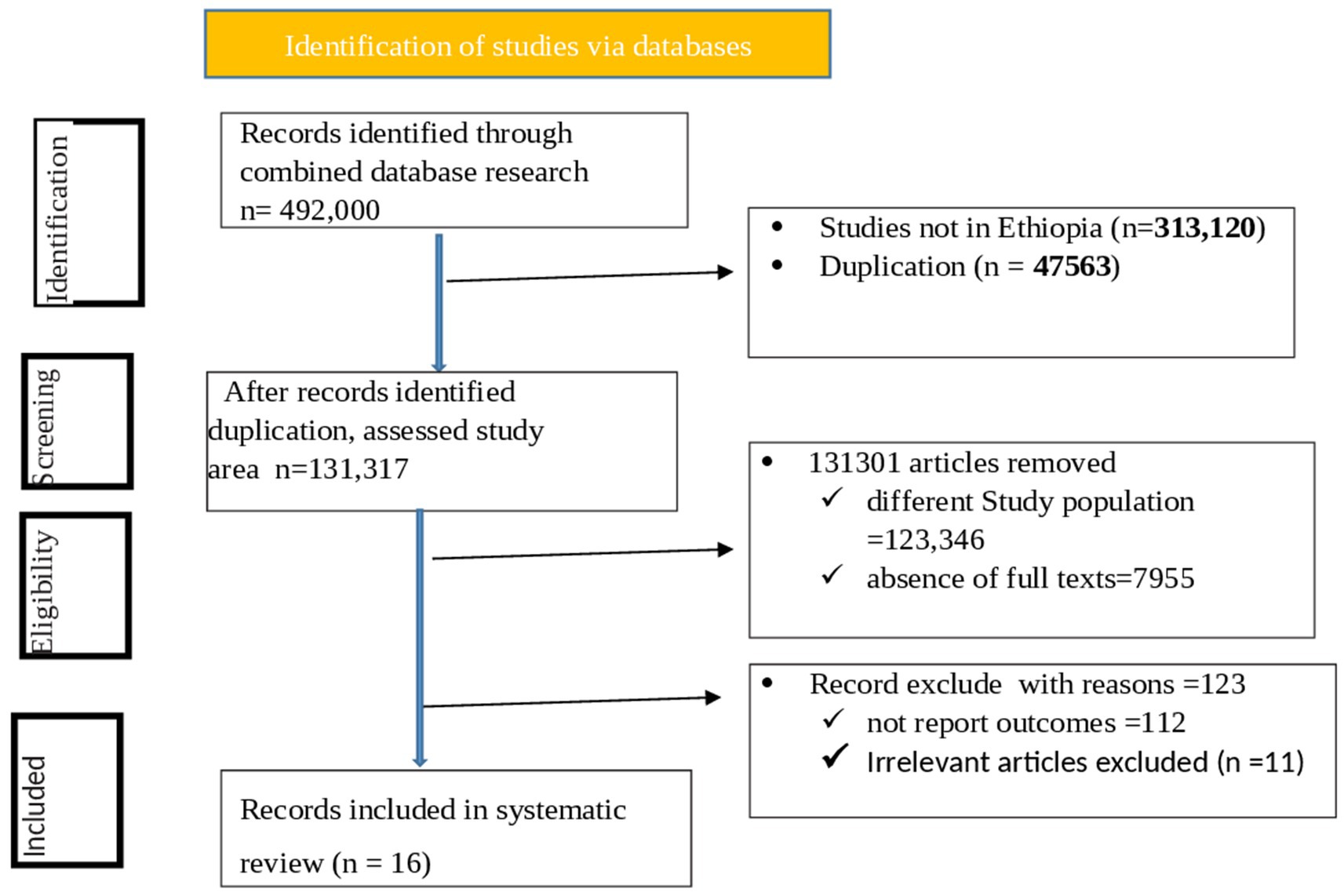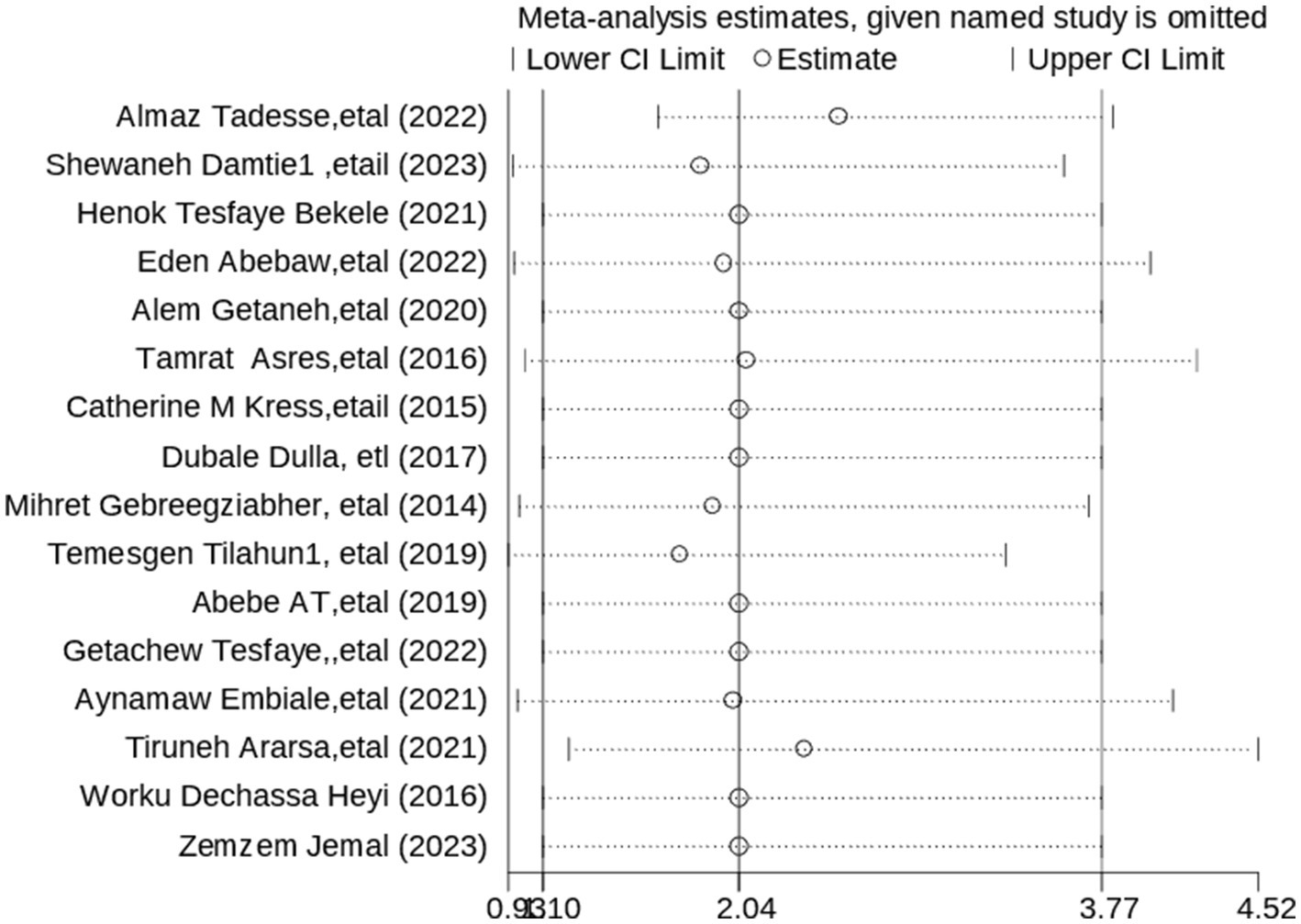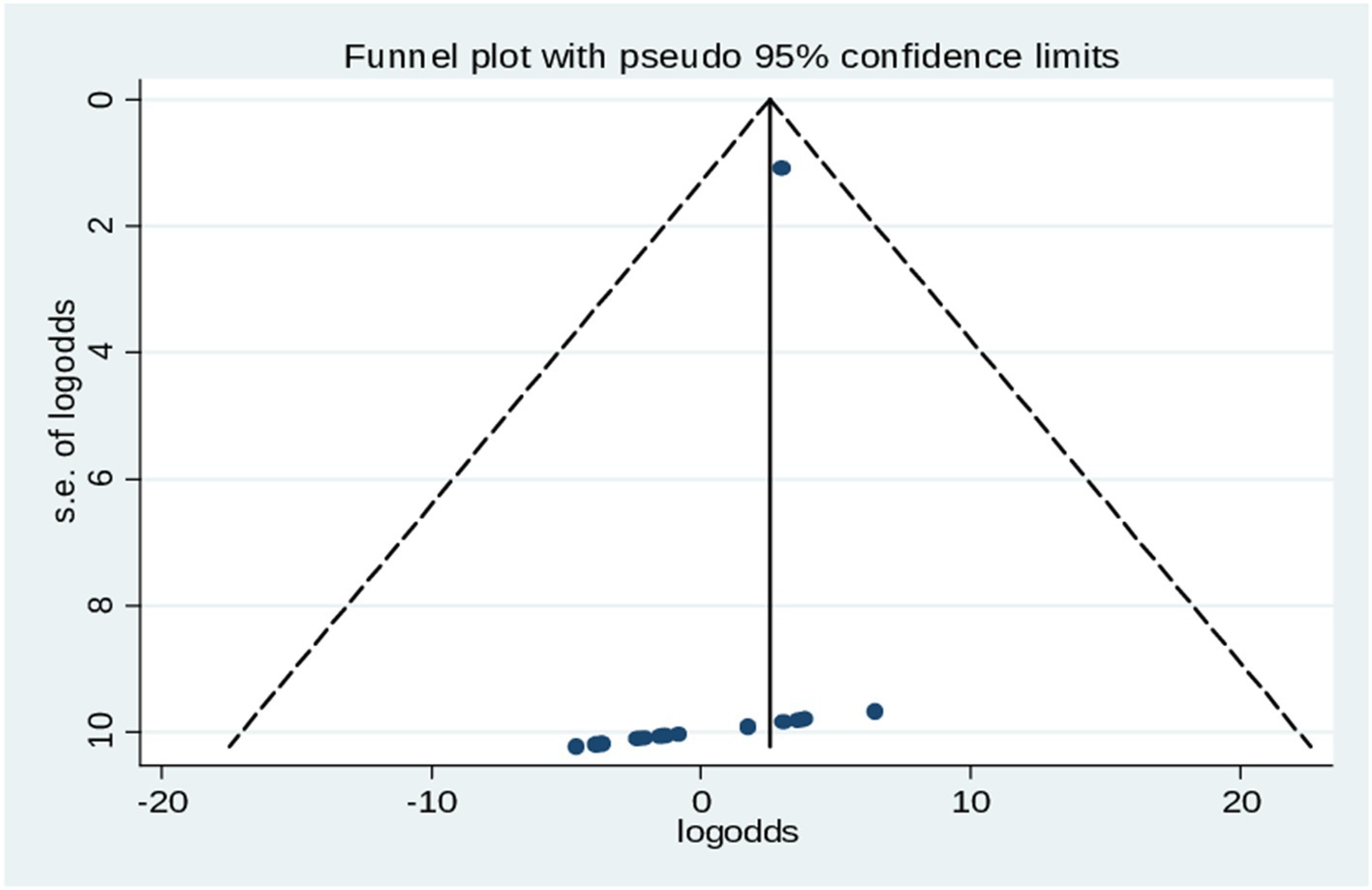- 1Department of Midwifery, Debark University College of Health Science, Debark Town, Ethiopia
- 2Departments of Nursing, Tedda Health Science College, Gondar City, Ethiopia
- 3Department of Environmental Health, College of Medicine and Health Science, Injibara University, Injibara, Ethiopia
- 4Department of Midwifery, Tedda Health Sciences College, Gondar City, Ethiopia
Introduction: Satisfaction with maternal health services serves as a vital indicator of the overall quality of care and significantly influences child healthcare outcomes. However, there remains a deficiency of comprehensive evidence concerning parents’ satisfaction with these vaccination services. This review aimed to evaluate the level of satisfaction with maternal health services and identify the factors that influence it among parents in Ethiopia.
Methods: Satisfaction with maternal health services serves as a vital indicator of the overall quality of care and significantly influences child healthcare outcomes. However, there remains a deficiency of comprehensive evidence concerning parents’ satisfaction with these maternal health services. This review aimed to evaluate the level of satisfaction with maternal health services and identify the factors that influence it among parents in Ethiopia.
Results: In this review, a total of 13 studies comprising 6,023 participants were included in the analysis. The findings indicated that the level of parental satisfaction with maternal health services was 63.5% (95% CI: 58.74, 72.44%). Several factors were identified as contributors to parental satisfaction with maternal health services, including knowledge about vaccination services (AOR = 1.93; 95% CI: 1.09, 3.42), favorable attitudes toward maternal health services (AOR = 3.23; 95% CI: 1.86, 5.62), welcoming approaches (AOR = 3.89; 95% CI: 1.80, 8.42), and the experience of waiting less than 30 min to receive services (AOR = 2.59; 95% CI: 1.25, 3.35).
Conclusion: Overall, only two-thirds of parents reported satisfaction with maternal health services. Key factors influencing this level of satisfaction included the healthcare providers’ welcoming approach, waiting times of under 30 min at health facilities, and parents’ knowledge and attitudes toward vaccination. To enhance parental satisfaction, it’s essential to address these identified factors. Improving timely and welcoming interactions in healthcare service delivery is highly recommended. Ultimately, boosting parental satisfaction with maternal healthcare services calls for a comprehensive approach that emphasizes respectful interactions and efficient service delivery.
Systematic review registration: PROSPERO ID CRD42024577054.
Introduction
The World Health Organization (WHO) launched the Expanded Program on Immunization (EPI) in 1974 to address vaccine-preventable diseases (1). The EPI is recognized as one of the most significant public health initiatives globally, as it has substantially reduced morbidity and mortality related to childhood infections (2). Its effective implementation ensures high-quality care, making it a vital component of healthcare delivery systems. EPI services provide valuable insights into service operations from the clients’ perspectives and highlight the necessary adjustments to meet their expectations (3, 4).
In 2021, global immunization reports revealed that approximately 25 million children were either unvaccinated or received insufficient vaccinations in certain areas (5). Nearly 3 million children die each year from vaccine-preventable infectious diseases, with around 2 million of these deaths occurring in developing countries before the age of five (6). In sub-Saharan African nations, about 4.4 million child deaths annually are linked to inadequate immunization coverage, primarily due to communicable diseases that could be prevented through vaccination (7). Although the Ethiopian Ministry of Health’s sector transformation plan aimed to prioritize child health and achieve 100% immunization coverage for all children under two by 2021, universal childhood immunization has largely not been realized (8). This gap has led to an estimated 472,000 children dying each year before their fifth birthday, mainly from vaccine-preventable diseases (9). According to the Ethiopian Mini Demographic and Health Survey (EDHS), national immunization coverage was only 76% in 2019, falling short of the national target of 100% by 2025 (10). In comparison, an Ethiopian child is 30 times more likely to die before the age of five than a child in Western Europe (11). This concerning underreporting rate presents serious risks, including fatalities, disabilities, the resurgence of previously eradicated infectious diseases, and negative health outcomes for children.
Parental satisfaction with the services offered is a crucial aspect of healthcare quality and is closely linked to the use of maternal and child health services (12). Valuing parents’ autonomy, dignity, emotions, and preferences creates a positive psychological environment that improves clinical outcomes and client retention, while also decreasing the risk of malpractice claims related to EPI services (13). The perceived satisfaction level of parents visiting healthcare facilities serves as a key indicator of the quality of EPI services (14). To enhance parental satisfaction, various interventions have been attempted (15). Recent initiatives have aimed at preventing abusive and disrespectful maternal care to improve child immunization coverage through the effective delivery of quality care (16, 17). Satisfied parents are more inclined to return for necessary services and recommend these services to others, making satisfaction a vital measure of healthcare quality (15). Research has suggested the importance of providing client-centered, high-quality services for children under 5 years old (18). However, challenges persist in addressing parental satisfaction during child immunization services. These challenges need to be tackled through summarized evidence to enhance the quality of healthcare service delivery (19). Without addressing parental satisfaction during routine maternal health services, Ethiopia has faced difficulties in achieving its targeted figures and sustainable development goals (20). Parental satisfaction reflects how well parents believe their needs and expectations are met by the services offered, which is crucial for encouraging respectful and evidence-based care to increase child immunization rates and enhance care quality (21). Various initiatives focus on enhancing the service process, ensuring a steady supply of vaccines and logistics, and providing training on child vaccinations (22, 23). Despite providing various training programs focused on child vaccinations, significant challenges persist regarding the capacity of healthcare providers across the nation. This affects the delivery of high-quality standard services for children under 5 years old (24).
To date, there have been different (25–27) studies conducted on the level of parental satisfaction with childhood immunization in Ethiopia. However, these studies have revealed inconsistent findings on the level of satisfaction with childhood vaccines, ranging from 37.4% (28) to 84.65% (29), and varying degrees of quality scores. Furthermore, the impact of various socio-demographic, socioeconomic, varying healthcare provider approaches, and a lack of technical support on the level of parental satisfaction in Ethiopia remains inconclusive (30, 31). The main goal of this review was to summarize the findings from thirteen primary studies on the level of satisfaction with childhood vaccines. By consolidating these studies, it becomes easier to summarize their results. This was the first systematic review and meta-analysis on satisfaction with childhood vaccines and their associated factors in Ethiopia.
Therefore, this review aims to assess the pooled level of parental satisfaction with childhood vaccination services and associated factors in Ethiopia. The findings will help quality assurance activities that assess parental satisfaction with maternal health service care can provide valuable insights into children’s healthcare experiences. Client satisfaction serves as an effective proxy indicator for measuring health outcomes and plays a crucial role in enhancing the quality of health services. Improved quality of maternal health services is expected to lead to increased maternal health service coverage both in specific service areas and across the country. Furthermore, identifying factors associated with parental satisfaction regarding maternal health services is essential for encouraging adherence to maternal health services and achieving the intended control of vaccine-preventable diseases.
Materials and methods
The Preferred Reporting Items for Systematic Reviews and Meta-Analyses (PRISMA) checklist was utilized (Supplementary Table S1, PRISMA Checklist, 2020). Systematic Review Registration: (PROSPERO ID CRD42024577054).
Search strategy and data sources
This review and meta-analysis were developed based on the PRISMA (Preferred Reporting Items for Systematic Review and Meta-Analysis) guideline (32). Studies about the level of satisfaction toward maternal health services were identified through an online search of Scopus, Web of Science, PubMed/Medline, Science Direct, African Journal Online, and the Wiley Online Library from January 3 to 30, 2024. Additionally, a Google Scholar search was performed as a confirmatory measure to ensure that no primary studies were overlooked. The focus of this research was specifically on the level of satisfaction with maternal health services in Ethiopia. Medical Subject Headings thesaurus (MeSH) terms were searched with appropriate combinations of Boolean operators: “Satisfaction with maternal health services OR “prevalence of satisfaction with maternal health services,” OR “level of satisfaction with childhood Immunization services,” AND “parent,” OR” women,” OR “guardian,” OR “caregiver,” AND “determinant factors,” OR “associated factors” (Supplementary Table S2).
Study inclusion and exclusion criteria
All primary studies that utilized observational study designs, specifically cross-sectional studies, to assess the level of satisfaction with maternal health services and the associated factors were included. The predefined eligibility criteria were as follows:
Population
The participants needed to be parents (including fathers, mothers, and guardians) utilizing maternal health services.
Exposure
The focus was on determinants or factors associated with the level of satisfaction regarding maternal health services.
Study location
The studies were required to be conducted in Ethiopia.
Study design
All observational studies were considered.
Publication status
Both published articles and gray literature were included. From these 10 articles were published and three studies were unpublished.
Language
Peppers searched without language restriction; however, published only articles in English were considered.
The search included all primary published articles without restrictions on the year of publication. However, the articles retrieved were from the years 2016 to 2024.
Studies that did not state outcome measures, had study populations differing from parents regarding maternal health services, or were review articles, case series, letters, comments, or editorials were excluded. The inclusion criteria were defined using a modified Condition, Context/Setting, and Population (CoCoPop) framework (see Table 1). Searched associated factors like, sociodemographic characteristic, approaches of healthcare providers, parents’ knowledge and attitudes toward vaccination were searched from each included articles.

Table 1. Framework for determining the eligibility of studies of the prevalence of Satisfaction with maternal health Services and associated factors among parents in Ethiopia (CoCoPop).
Study screening and selection
First, four researchers (AMZ, YAF, WCT, and GMB) evaluated the studies using specific inclusion and exclusion criteria. They started by analyzing the titles and abstracts of the studies found in the databases. Then, eliminate duplicate research from each database that was exported to the citation manager program EndNote X 7. Afterward, the selected studies underwent a full-text screening. The PRISMA flow diagram was used to document the reasons for including or excluding each study. Finally, a list of studies eligible for data extraction in the systematic review and meta-analysis was prepared (Table 2). The data were extracted independently by three authors (AMZ, YAF, and WCT) reviewed the extracted data and engaged in discussions with the data extractors to ensure accuracy.

Table 2. Parents’ satisfaction toward maternal health services and associated factors in Ethiopia, 2024.
Outcome measurements
The study focused on assessing parents’ level of satisfaction with maternal health services. According to the included primary studies, the level of parents’ satisfaction was measured using (5-point Likert scale) questions (33–35). Factor mean was computed for each participant, and participants with a score equal to or above the factor were considered as parents were classified into two categories regarding their overall satisfaction with women’s health services: “satisfied” and “not satisfied.”
Quality assessment
The Newcastle-Ottawa Scale was utilized to assess the quality of the studies included in the review (36). This tool is structured into three main components. The first component consists of five stars and evaluates the methodological quality, considering factors such as the sampling process, sample size, response rate, and the identification of exposure or risk factors. The second component focuses on the comparability of the studies, with a maximum of two stars available. Lastly, the third component appraises the outcomes and statistical analyses of the primary studies, allowing for up to three stars. Lastly, the third component appraises the outcomes and statistical analyses of the primary studies, allowing for up to three stars.
Overall, this quality assessment tool contains 9 items that pertain to the risk of bias, producing scores that span from a minimum of “0” to a maximum of “9.” The risk of bias is categorized as low quality for scores under 6 and high quality for scores between 7 and 9. To ensure the reliability of the quality assessments, two authors (YAG and GMB, WCT) performed quality assurance checks, with any disagreements regarding the evaluations of the articles resolved through collaboration and discussion among all authors.
Publication bias and heterogeneity
We employed Cochran’s Q and I-squared statistics to evaluate heterogeneity among the studies. The interpretations for these statistics are as follows: a 0 to 40% range suggests that heterogeneity may not be significant, 40 to 60% indicates moderate heterogeneity, 60 to 90% signifies substantial heterogeneity, and a range of 90 to 100% denotes considerable heterogeneity (37). To investigate publication bias, we utilized both the funnel plot method for subjective observation and Egger’s test, where a p-value below 0.05 indicated the presence of publication bias (38). Additionally, a sensitivity analysis (leave-one-out) was performed to determine the impact of any individual study on the overall pooled prevalence, assuming homogeneity across groups. Subgroup analysis was also conducted based on the type of sampling technique used in the studies.
Data processing and analysis
Standardized data were extracted using the standard Microsoft Excel format by two authors (AMZ and WCT) and then exported into STATA version 11 software for further analysis. The following data were extracted from the included studies: name of primary author, publication year, and country’s region of the study, sample size, prevalence, study population, sampling technique, study design, and the selected predictors of the level of satisfaction with childhood vaccination services. The second author (YAF) revised the extracted data and discussed any discrepancies between the data extractors. Disagreements that occurred during data extraction were resolved through discussions among all authors. To combine the outcome data from accepted research, the authors employed the random-effects model. The data were reported as pooled outcome variables with a 95% confidence interval. Statistical heterogeneity was checked using the Cochrane Q-test and I2 statistics.
Results
Studies selection
The first search identified 146,987 articles from PubMed, Web of Science, Science Direct, African Journal Online, Google Scholar, and the Wiley Online Library. Of them, 97,000 articles were not studies conducted in Ethiopia, and 33,333 articles removed with different study populations, 2,683 due to duplications, and 9,955 articles excluded because of the absence of full texts. Ultimately, thirteen studies were included in the systematic review and meta-analysis, totaling 6,023 study participants (Figure 1).
Summary of primary studies
Regarding study design, all (100%) of the studies were cross-sectional, and thirteen (100%) of the studies had high-quality articles assessed by the Newcastle Ottawa Scale (≥7). The overall level of parental satisfaction with maternal health services was reported in various regions in Ethiopia; five (38.46%) of the 13 studies were from the Amhara Regional State, and four (30.77%) of the thirteen studies were from Southern Ethiopia. The sample sizes ranged from 245 to 722 studies, with to smallest to the greatest difference in sample size (Table 2).
The level of parents’ satisfaction with maternal health services
The pooled data from 6,023 study participants were used to estimate the level of satisfaction with maternal health services using meta-analysis. The overall pooled level of satisfaction with childhood immunization services was 63.6% (95% CI: 58.74, 72.44%) (Figure 2) with substantial heterogeneity across the studies (chi2 = 59.81 (d.f. = 12), (p = 0.000), and I2 = 79.9%) due to differences in healthcare infrastructure, cultural attitudes, or regional policies.
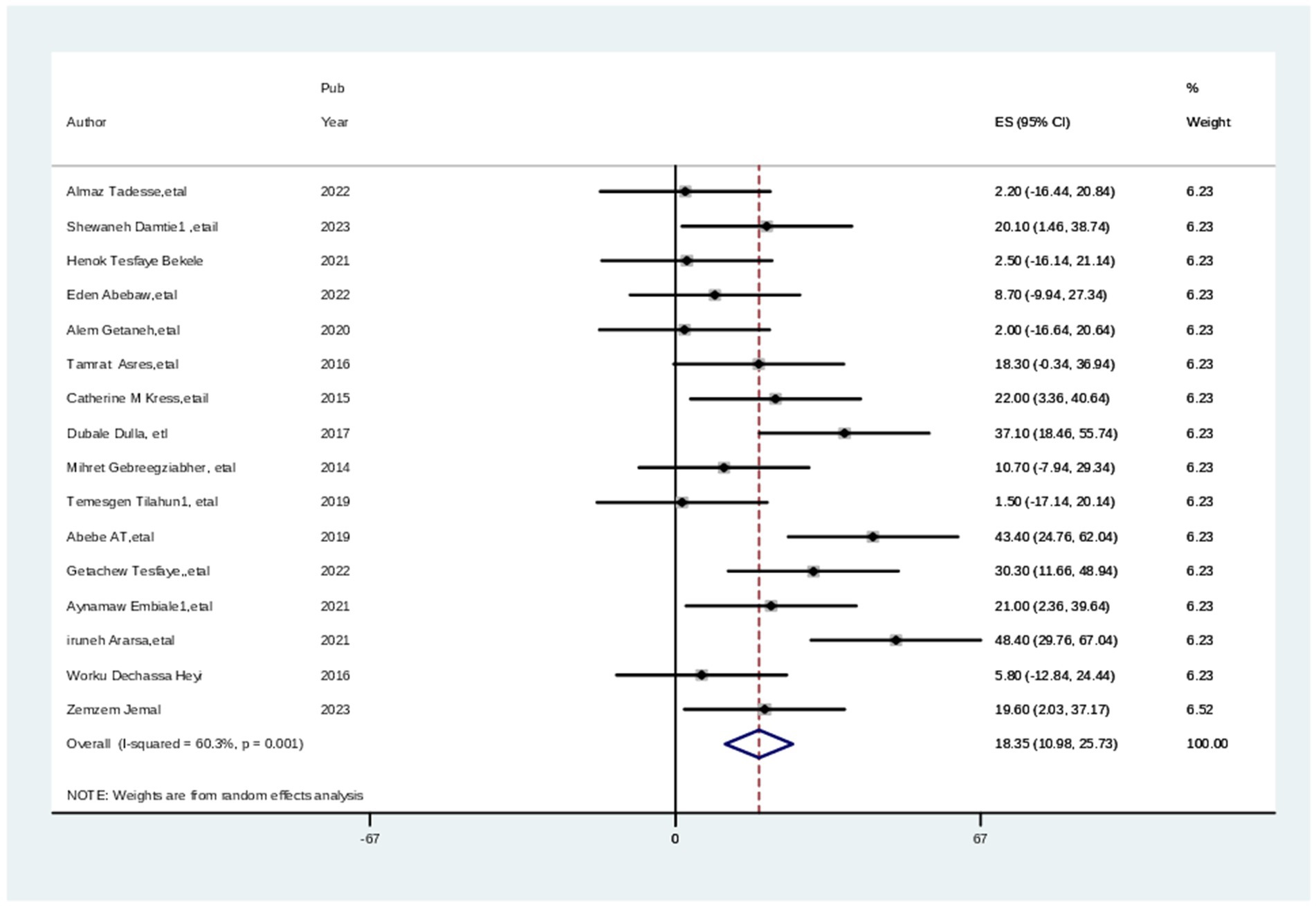
Figure 2. The pooled estimates the practice of healthcare professionals toward cervical cancer screening in Ethiopia.
Subgroup analysis
After stratification based on the study population, subgroup analysis was carried out to determine the sources of heterogeneity among the included articles. Therefore, subgroup analysis was conducted by sampling techniques for the level of satisfaction with maternal health services in Ethiopia. Based on the sampling technique categories the maximum level of satisfaction with maternal health services among parents was 74.63% (95% CI: 63.19, 86.06), I2 = 86.4, p = 000, in multistage random sampling method while 62.35% (95% CI: 55.41, 69.30), I2 = 75.5, p = 0.017, in simple random sampling Technique (Figure 3).
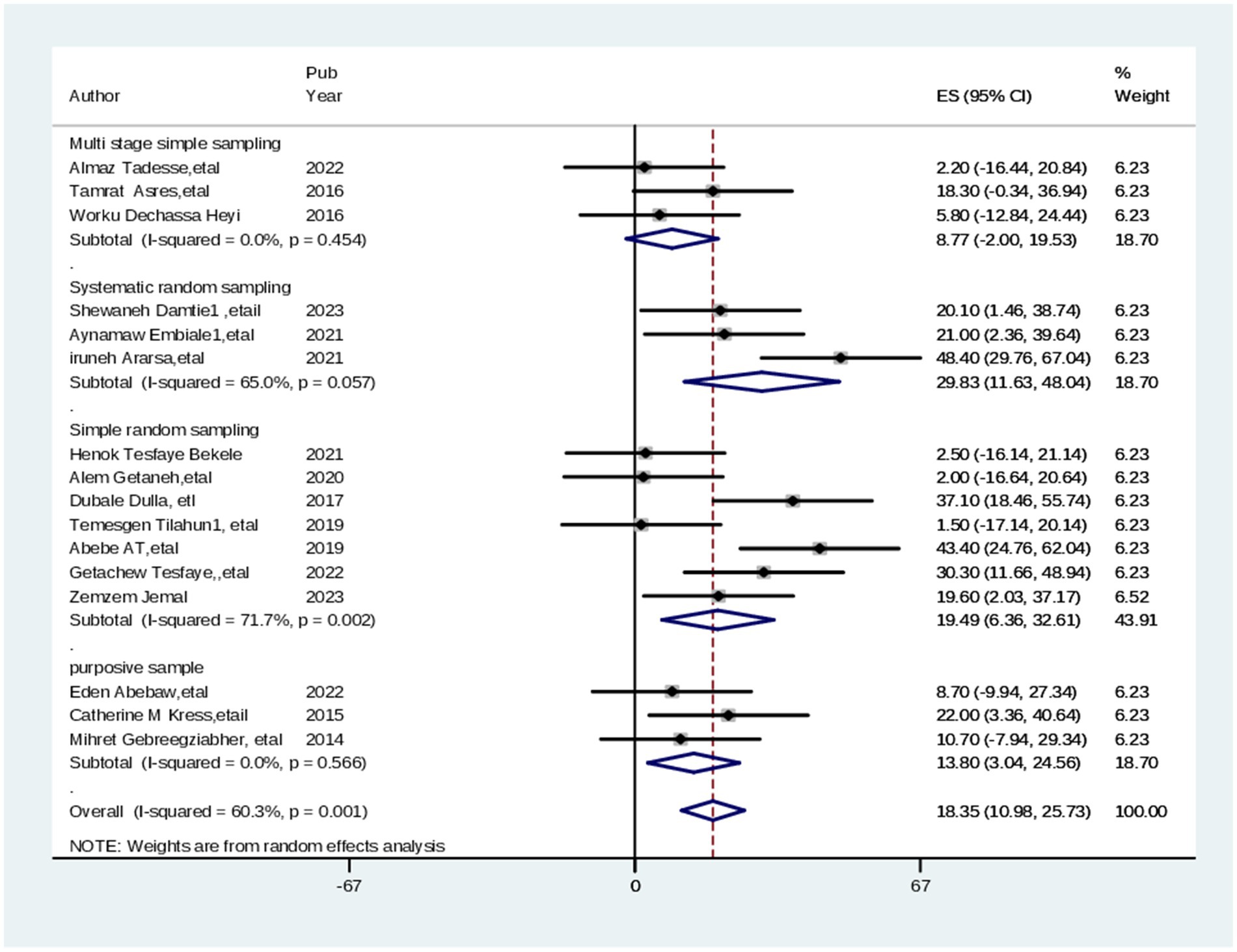
Figure 3. Subgroup analysis (by sampling technique) of studies included in meta-analysis on practice of cervical screening among healthcare professionals, 2024.
From systematic random sampling, the level of satisfaction with maternal health services among parents was 62.62% (95% CI: 51.59, 73.65), I2 = 84.6, p = 000. The level of heterogeneity is not identified. Hence, the effects of study participants, sample size, and year of study on the studies were examined using a meta-regression. However, there was no significant prediction of heterogeneity based on the assessed variables (sample sizes, study participants, and year of study) (Table 3). In the adjusted model, neither sampling sample size, study participants, nor the year of study indicated heterogeneity in the effect size was consistent with the pooled prevalence.

Table 3. Univariable meta-regression analysis results for the level of satisfaction with maternal health services among parents in Ethiopia.
Sensitivity analysis
To evaluate the potential sources of heterogeneity on the pooled level of satisfaction with maternal health childhood vaccination services, a sensitivity analysis was performed using the random effects model. Hence, the sensitivity analysis revealed that the studies on the pooled satisfaction toward childhood vaccination services among parents (Figure 4).
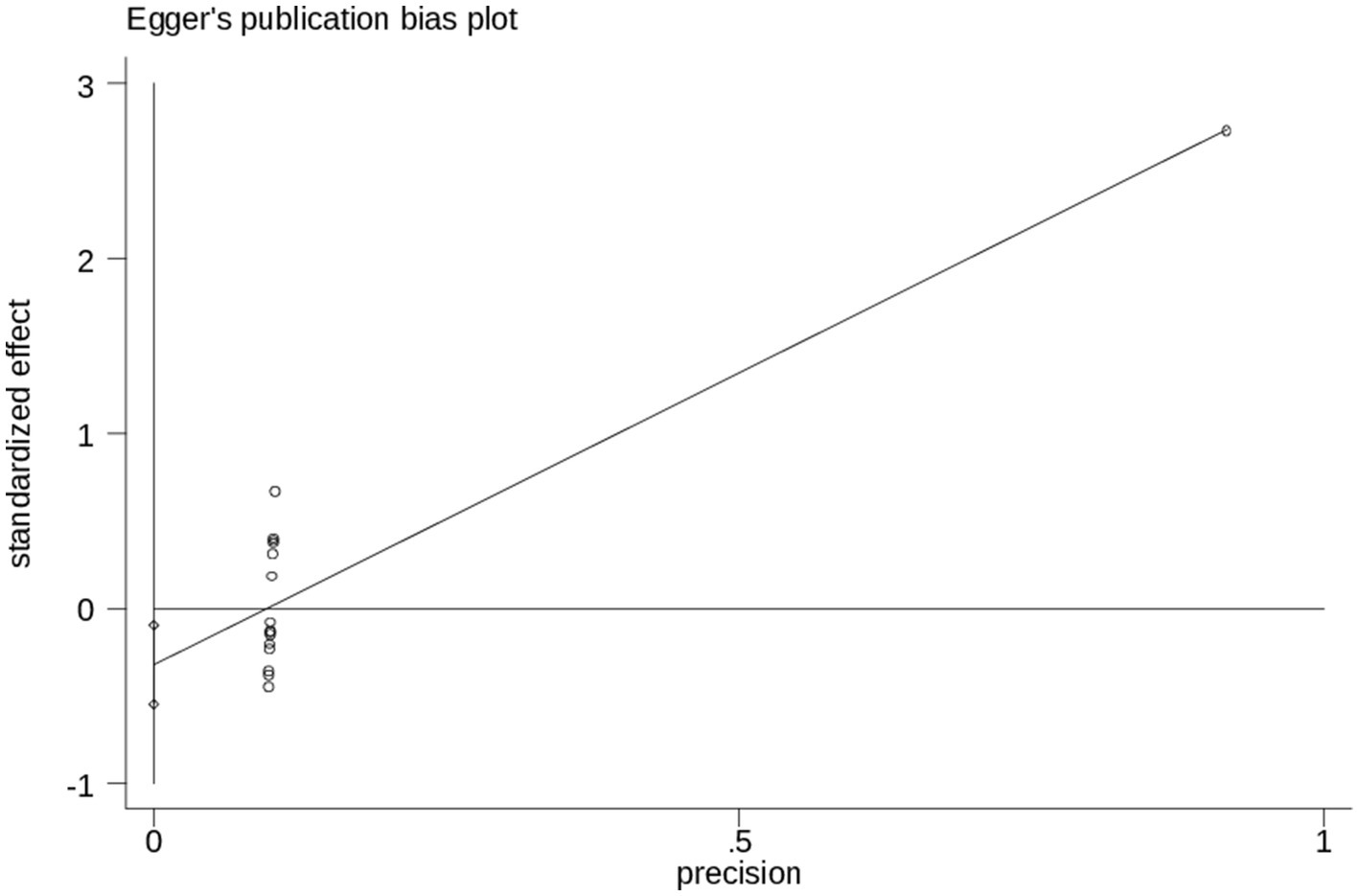
Figure 4. Egger’s test result for healthcare professionals and its associations with of cervical cancer screening practice in Ethiopia, 2024.
Heterogeneity across studies might happen due to variations in study populations, such as age, sex, ethnicity, and health status, affecting outcomes. Differences in interventions, like level of education, duration, or delivery method, can also result in varied effectiveness. Variations in study sampling technique, such as sampling technique type versus systematic random sampling, introduce further heterogeneity, as each design has unique strengths and weaknesses. Statistical analysis methods can yield different effect size estimates, leading to inconsistencies.
Publication bias
According to objectively, Egger’s test result for publication bias showed statistically significant results (p = 0.005), which revealed that, there was evidence of absence of publication bias (p-value = 0.062) (Table 4), and the funnel plot results revealed symmetric shape, indicating the absence of publishing bias symmetrical observation of the funnel plot as demonstrated in (Figure 5).
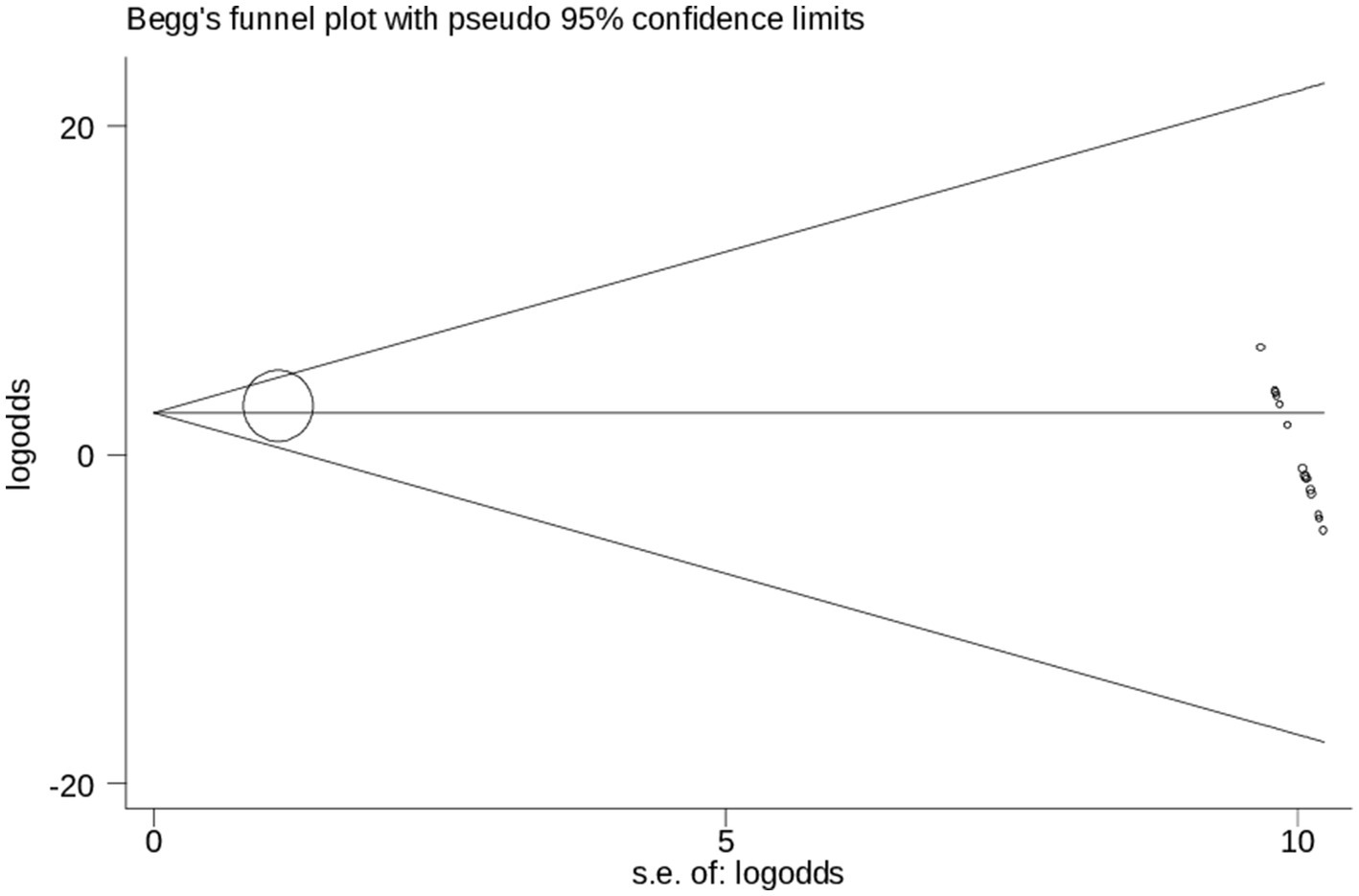
Figure 5. Begg’s test results for healthcare professionals and its association with of cervical cancer screening practice in Ethiopia, 2024.
Factors with parents’ level of satisfaction with maternal health services
Associated factors contribute to the level of parents’ satisfaction with maternal health services. Based on this meta-analysis, different pooled variables relating to the level of satisfaction with maternal health services among parents were assessed. However, only four pooled variables were different among parents at the national level (Ethiopia). Thus, healthcare providers’ greeting or welcome approach, less waiting time, comprehensive knowledge, and attitudes were identified as significant determinants of the level of parents’ satisfaction with child vaccine services. The associations between the level of satisfaction with maternal health services and the knowledge of parents about childhood vaccination were computed from eight studies (29, 39–42). The odds of the level of the satisfaction with maternal health services were 1.93 times greater (AOR = 1.93; 95% CI: 1.09, 3.42) among parents who had good knowledge about maternal health compared with those who had poor knowledge (Figure 6). Arandom effect model analysis was used to reduce the heterogeneity: chi-squared = 19.35 (d.f. = 4), p = 0.001, and I2 = 79.3%. Four studies (3, 29, 39, 40) showed that parents who had a favorable attitude had a significant association with their level of satisfaction with maternal health during childhood. Thus, parents who had a favorable attitude toward maternal health services were 3.23 times (AOR = 3.23; 95% CI: 1.86, 5.62) more likely to have a high level of satisfaction with maternal health than those who had an unfavorable attitude. A random effect model was also used in this meta-analysis as the included studies were characterized by high heterogeneity chi-squared = 94.42% (d.f. = 7) (p = 0.000), and I2 = 92.6% (Figure 7).
Moreover, the pooled odds ratio estimates level of satisfaction with maternal health in eight studies (3, 14, 29, 39, 40, 42–44) showed that parents who received greeting/welcome approach services from healthcare providers were 3.89 times (AOR = 3.89; 95% CI: 1.80, 8.42) more likely to have high level of satisfaction during child vaccination than parents who received disrespectful care. In this meta-analysis, the included studies were characterized by the presence of substantial heterogeneity (chi-squared = 153.62 (d.f. = 7), p = 0.000, and I2 = 95.4%). Thus, a random effect model analysis (Figure 8).
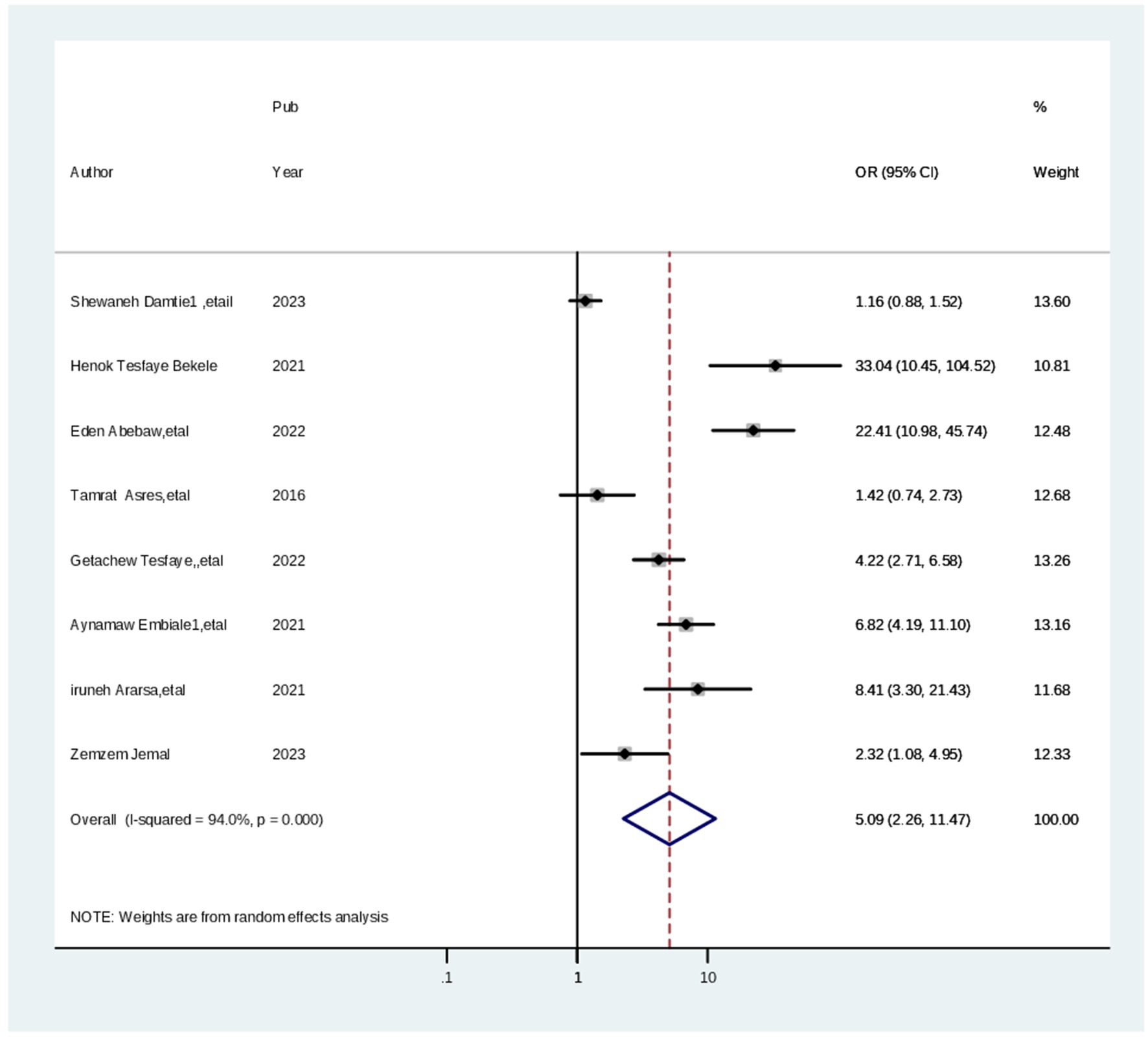
Figure 8. Forest plot showing the pooled odds ratio of the associations between having a knowledge and cervical screening practice among healthcare professionals in Ethiopia, 2024.
Finally, the pooled odds ratio estimates the level of parents satisfaction with child hood vaccination in eight (29, 33, 39–41, 45, 46) studies showed that parents who waited less than 30 min to receive maternal health services at health facilities were 2.59 times (AOR = 2.59; 95% CI: 1.25, 3.35) more likely to have high level of parents satisfaction during maternal health than parents who waited more time. In this meta-analysis, the included studies exhibited substantial heterogeneity (chi-squared = 98.58 (d.f. = 7), p = 0.000, and I2 = 92.9%). Thus, a random effect model analysis was carried out (Figure 9).
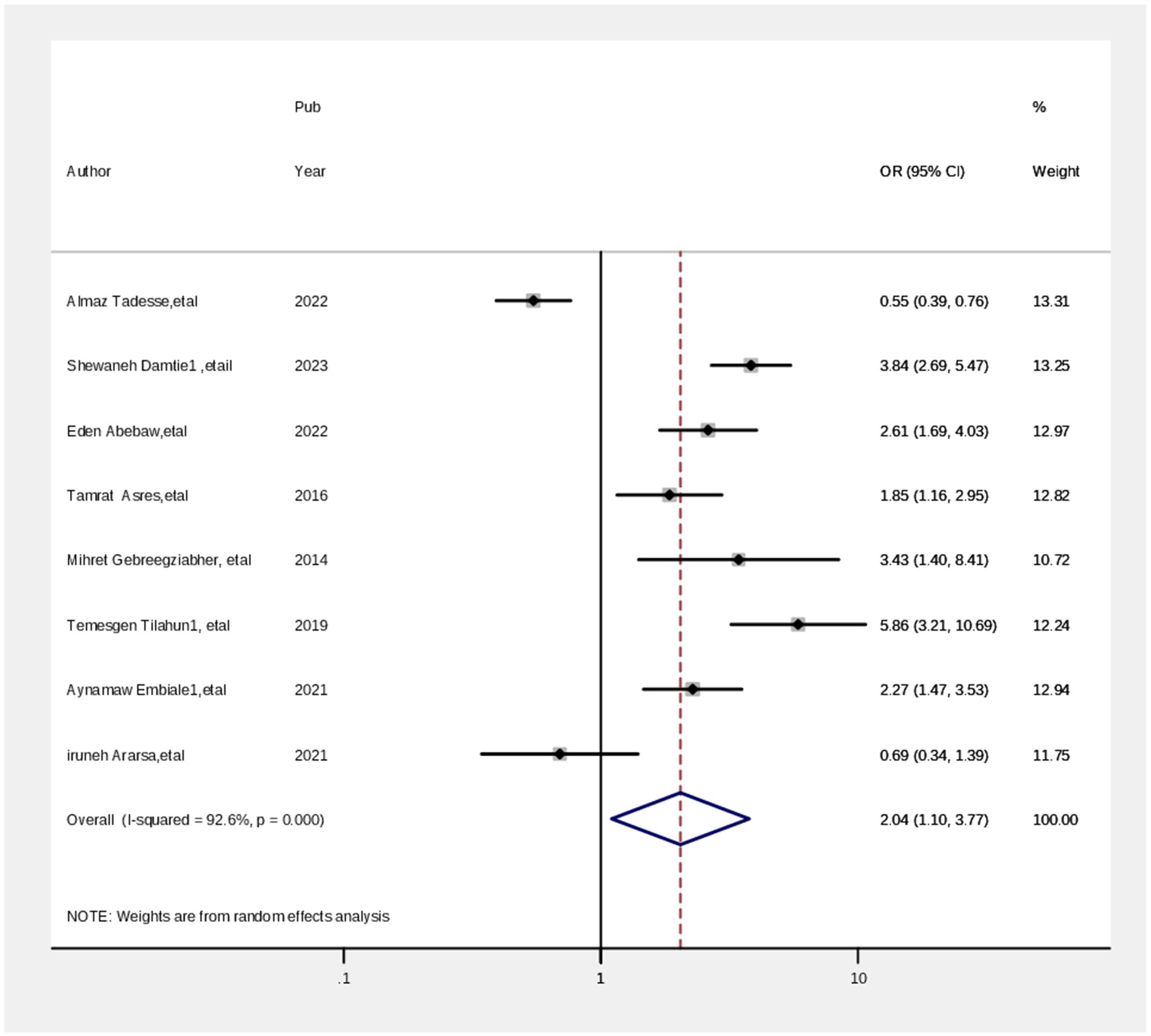
Figure 9. Forest plot showing the pooled odds ratio of the associations between having a welcoming approach among healthcare professionals in Ethiopia, 2024.
Discussion
This systematic review and meta-analysis aimed to assess parental satisfaction with maternal health services and the associated factors in Ethiopia. Understanding parents’ satisfaction with childhood vaccine services in Ethiopia requires a comprehensive approach that considers the interplay of social, economic, and political factors. By addressing these factors, policymakers can improve vaccination services and increase overall satisfaction among parents, ultimately leading to higher vaccination rates and better public health outcomes (Figure 10).
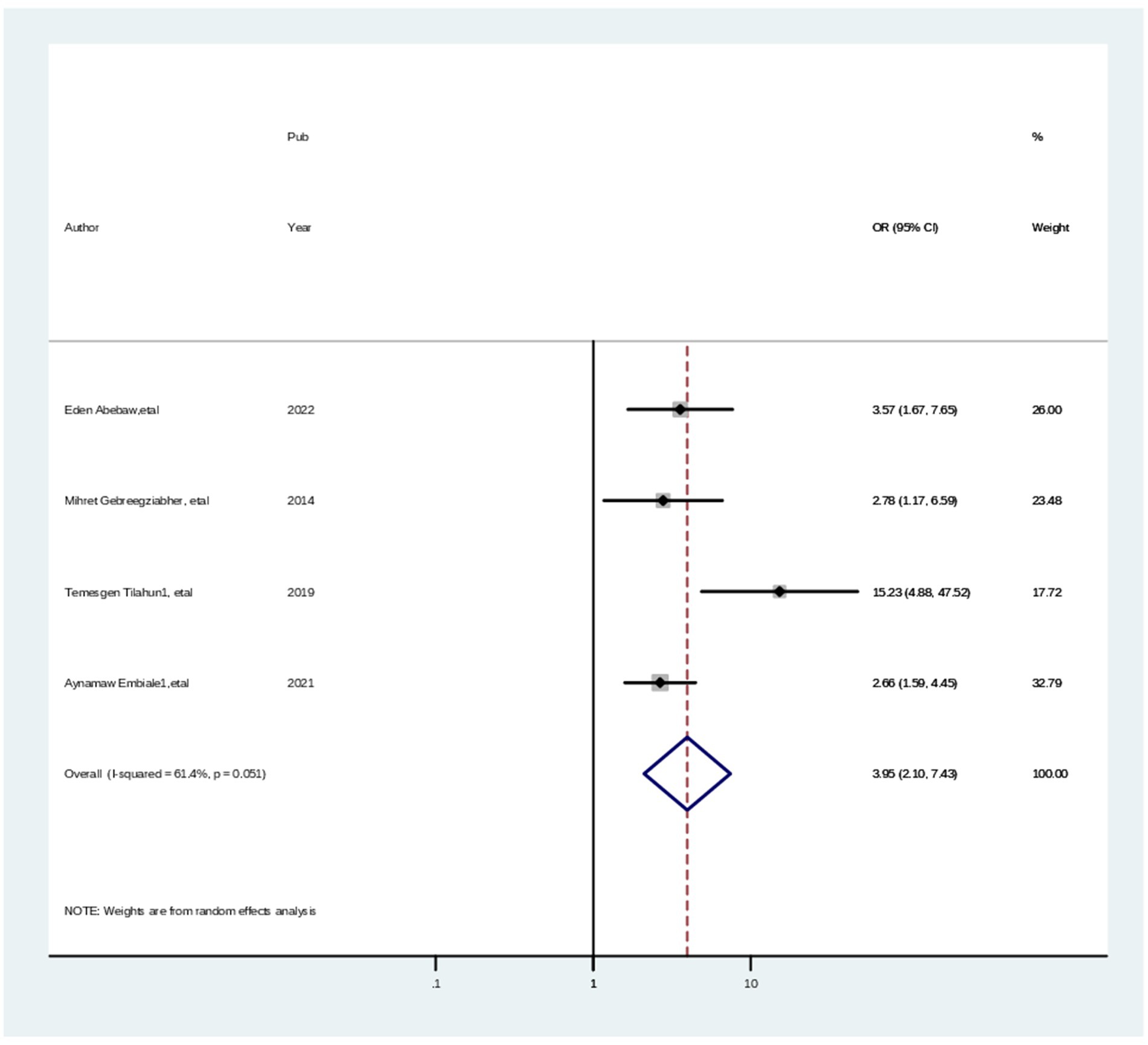
Figure 10. Forest plot showing the pooled odds ratio of the associations between took training cervical screening practice among the healthcare professionals in Ethiopia, 2024.
The pooled level of parental satisfaction with maternal health services among parents was 65.6% (95% CI: 58.74, 72.44%). This indicates that nearly two-thirds of parents were satisfied with the maternal health services. This outcome has significant implications for the Ethiopian healthcare system. As outlined in the Ethiopian government’s Health Sector Transformation Plan II, improving the provision of equitable, high-quality, and comprehensive health services is central to the sector’s objectives, which extend beyond more health investments to promote universal coverage. The national agenda emphasizes the importance of quality of care. Therefore, the findings of this nationally representative study may provide valuable insights into the quality of maternal health healthcare services and support the implementation of the current national health sector plan (47).
The level of parental satisfaction with immunization in this study was significantly lower than the results reported in other countries, such as Egypt (95.2%) (48), India, (93.2%) (49), Saudi Arabia, (87.4%) (50), China, (90%) (51), Australia, (99.5%) (52), and Nigeria, (99.2%) (53). This large discrepancy may be attributed to differences in the quality of healthcare services and variations in the methods used to estimate parents’ satisfaction levels. In the Ethiopian primary study, parental satisfaction with maternal health services was assessed using the demarcation threshold formula, whereas other studies often utilized mean and median cutoff points for their measurements. In addition to this, the lower educational status of the study participants may also contribute to this difference in satisfaction levels. Our findings indicated that parents’ satisfaction varied based on the specific measurement items used. Parents who were most satisfied with the services they received emphasized that having friendly healthcare personnel was a key factor in their satisfaction. A study conducted in India found that the degree of friendliness exhibited by service providers increased client satisfaction by 33.6% (13), a finding also lower than that of a study conducted in China (39).
Furthermore, this may be the result of differences in cultural beliefs, and social norms can vary from one country to another in terms of quality and accessibility factors that can have a significant impact on access to healthcare and maternal health services, and consequently affect satisfaction with these services. It is also possible to justify this claim by pointing out that healthcare infrastructure can vary from one country to another in terms of quality and accessibility. The availability of well-equipped healthcare facilities, including vaccination centers, may be fully accessible in some parts of Nigeria and Australia.
However, this pooled level of parental satisfaction in this review aligned with findings from other studies, such as 60% in Vietnam (54) and 72.3% in Iraq (55), which may be because of similarities in the satisfaction measurement items used. Furthermore, this study revealed that knowledgeable parents were associated with a higher level of satisfaction with maternal health services.
Parents who possessed good knowledge about childhood vaccination services were more likely to report a high level of parental satisfaction compared to their counterparts. This finding was supported by previous studies (13, 52). This could be because parents with adequate knowledge about the importance of childhood vaccinations are more likely to develop a higher level of satisfaction with the services provided. A piece of evidence from India also revealed that a high level of satisfaction was closely linked to knowledge of child immunization service factors (13).
Participants with a favorable attitude were 3.23 times more likely to report a high level of satisfaction with maternal health compared to those who had an unfavorable attitude. This can be attributed to the fact that individuals with a positive attitude toward maternal health services are more likely to recognize the benefits of these services for those in need. Additionally, having a positive perspective on the advantages and disadvantages of childhood immunization may encourage parents and caregivers to engage in a friendly manner while receiving services. This finding was consistent with various studies conducted in Ethiopia and Saudi Arabia (56, 57). Overall, a positive attitude toward maternal health services not only enhances satisfaction but also fosters a more supportive and cooperative interaction between caregivers and healthcare providers.
Moreover, the results demonstrated that healthcare providers’ approaches were significant factors contributing to parental satisfaction with maternal health services. Specifically, the findings revealed that a welcoming or greeting approach by healthcare providers positively influenced parents’ satisfaction levels. For instance, parents who received greetings from care providers during vaccination services were 3.89 times more likely to express satisfaction compared to those who did not. Establishing effective and friendly interactions between healthcare providers and parents can help address the concerns of vaccine-supportive parents and encourage hesitant parents to accept vaccinations. This review was supported by studies conducted in Ghana, which indicated that respectful care and good communication between healthcare providers and parents were essential components of quality medical practice (19, 58). A possible justification that has the potential to be raised is that greetings can convey care, empathy, and support. For mothers who may be anxious or stressed about their child’s healthcare visit, receiving a friendly greeting can help alleviate those emotions. Feeling emotionally supported contributes to a positive service experience and improves satisfaction. A likely explanation is that when healthcare providers greet mothers warmly and respectfully, it fosters a positive rapport and creates a welcoming atmosphere. This personal touch improves the overall experience and contributes to increasing satisfaction with the service received. Therefore, implementing multidisciplinary interventions throughout the healthcare continuum to address dissatisfaction and provide training in respectful and compassionate care approaches is crucial for strengthening the overall quality of care.
Finally, this systematic review and meta-analysis found that a shorter service waiting time (less than 30 min) was a significant predictor of parental satisfaction with maternal health services. Parents who waited less than 30 min were 2.58 times more likely to report a high level of satisfaction with maternal health services compared to those who experienced longer wait times at health facilities. Similarly, reviews from China and Nigeria indicated that caregivers who waited longer than 30 min were less likely to be satisfied than those who had shorter wait times (53, 59). This similarity may be attributed to the subjective assessments and expectations of caregivers, as well as their acceptance of services under comparable circumstances. Some caregivers prioritize the services they desire, regardless of the length of time they must wait for those services. Quality assurance activities that assess the level of parental satisfaction during maternal health services can provide valuable insights into identifying children who are less likely to receive timely vaccination services.
Strengths and limitations
To the best of our knowledge, all sections of the manuscript were written according to the PRISMA 2020 guidelines, and the quality of each study was assessed using the Newcastle-Ottawa Scale quality assessment tool. Although sensitivity analyses and subgroup analyses were employed to mitigate the influence of heterogeneity among the included studies remained significant. The nature of cross-sectional studies can identify associations between variables but cannot establish cause-and-effect relationships. Since data is collected at one point in time, it is difficult to determine whether one variable influences another. Although this comprehensive review does not represent all 14 regions of Ethiopia, it has been conducted in seven regions of the country. To be deeply understood, conducting qualitative and longitudinal studies with participants is recommended for future research.
Conclusion and recommendation
This review indicated that only two-thirds of parents expressed satisfaction with maternal health services. The key factors influencing this level of satisfaction included the healthcare providers’ welcoming approach, waiting times of less than 30 min at health facilities, and the parents’ knowledge and attitudes toward vaccination.
To enhance parental satisfaction in Ethiopia and similar contexts, it is essential to address these identified factors. This includes improving the healthcare delivery system by ensuring timely and respectful maternal care, particularly through welcoming approaches. Additionally, it is recommended that the Ethiopian Ministry of Health implement respectful maternity care training for healthcare providers. This multifaceted approach could significantly improve the experience of parents and ultimately enhance satisfaction with healthcare services.
Data availability statement
The original contributions presented in the study are included in the article/Supplementary material, further inquiries can be directed to the corresponding author.
Author contributions
AZ: Conceptualization, Data curation, Formal analysis, Funding acquisition, Investigation, Methodology, Project administration, Resources, Software, Supervision, Validation, Visualization, Writing – original draft, Writing – review & editing. WT: Conceptualization, Data curation, Formal analysis, Funding acquisition, Investigation, Methodology, Project administration, Resources, Software, Supervision, Validation, Visualization, Writing – original draft, Writing – review & editing. GB: Conceptualization, Data curation, Formal analysis, Funding acquisition, Investigation, Methodology, Project administration, Resources, Software, Supervision, Validation, Visualization, Writing – original draft, Writing – review & editing. YA: Conceptualization, Data curation, Formal analysis, Funding acquisition, Investigation, Methodology, Project administration, Resources, Software, Supervision, Validation, Visualization, Writing – original draft, Writing – review & editing.
Funding
The author(s) declare that no financial support was received for the research and/or publication of this article.
Acknowledgments
The authors would like to thank the authors of the included primary studies, which were used as sources of information to conduct this systematic review and meta-analysis.
Conflict of interest
The authors declare that the research was conducted in the absence of any commercial or financial relationships that could be construed as a potential conflict of interest.
Publisher’s note
All claims expressed in this article are solely those of the authors and do not necessarily represent those of their affiliated organizations, or those of the publisher, the editors and the reviewers. Any product that may be evaluated in this article, or claim that may be made by its manufacturer, is not guaranteed or endorsed by the publisher.
Supplementary material
The Supplementary material for this article can be found online at: https://www.frontiersin.org/articles/10.3389/fpubh.2025.1401498/full#supplementary-material
References
1. Lambach, P, Orenstein, W, Silal, S, Sbarra, AN, Koh, M, Aggarwal, R, et al. Report from the World Health Organization’s immunization and vaccines related implementation research advisory committee (IVIR-AC) meeting. Vaccine. (2024) 42:1424–1434. doi: 10.1016/j.vaccine.2024.02.014
2. Mavundza, EJ, Cooper, S, and Wiysonge, CS. A systematic review of factors that influence parents’ views and practices around routine childhood vaccination in Africa: a qualitative evidence synthesis. Vaccine. (2023) 11:563. doi: 10.3390/vaccines11030563
3. GebreEyesus, FA, Assimamaw, NT, GebereEgziabher, NT, and Shiferaw, BZ. Maternal satisfaction towards childhood immunization service and its associated factors in Wadla District, north Wollo, Ethiopia, 2019. Int J Pediatr. (2020) 2020:1–13. doi: 10.1155/2020/3715414
4. Tadesse, BH. Mothers’ satisfaction with institutional delivery service in public health facilities of Omo Nada District, Jimma zone. Clin Med Res. (2017) 6:23. doi: 10.11648/j.cmr.20170601.13
5. Castañeda-Orjuela, C, and De la Hoz-Restrepo, F. Criteria for new vaccine introduction in a National Expanded Program on immunization: a survey of expanded program on immunization managers. Value Health Reg Issues. (2022) 31:142–7. doi: 10.1016/j.vhri.2022.05.001
6. Smith, LE, Amlôt, R, Weinman, J, Yiend, J, and Rubin, GJ. A systematic review of factors affecting vaccine uptake in young children. Vaccine. (2017) 35:6059–69. doi: 10.1016/j.vaccine.2017.09.046
7. Danovaro-Holliday, MC, Gacic-Dobo, M, Diallo, MS, Murphy, P, and Brown, DW. Compliance of WHO and UNICEF estimates of national immunization coverage (WUENIC) with Guidelines for Accurate and Transparent Health Estimates Reporting (GATHER) criteria. Gates Open Res. (2021) 5:77. doi: 10.12688/gatesopenres.13258.1
8. Federal Ministry of Health AA. Ethiopia national expanded programme on immunization. Addis Ababa, Ethiopia: Federal Ministry of Health. (2016–2020).
9. Berhane, Y. Universal childhood immunization: a realistic yet not achieved goal. Ethiop J Health Dev. (2008) 22:146–215. doi: 10.12691/ajphr-6-3-6
10. Rockville, M. Ethiopia Mini Demographic and Health Survey, Ethiopian Public Health Institute (EPHI). Ethiopia: EPHI (2019).
11. WT, WA, Merdekios, B, Tilahun, M, and Ayele, G. Expanded program of immunization coverage and associated factors among children aged 12–23 months in Arba Minch town and Zuria District, southern Ethiopia, 2013. BMC Public Health. (2014) 14:464. doi: 10.1186/1471-2458-14-464
12. WHO. Delivering quality health services. A global imperative for universal health coverage. Geneva: World Health Organization, Organization for Economic Co-operation and Development, and the World Bank (2018).
13. Nath, B, Singh, JV, Awasthi, S, Bhushan, V, Singh, SK, and Kumar, V. Client satisfaction with immunization services in urban slums of Lucknow district. Indian J Pediatr. (2009) 76:479–83.
14. Tesfaye, R, Worku, A, Godana, W, and Lindtjorn, B. Client satisfaction with delivery care service and associated factors in the public health facilities of Gamo Gofa zone, Southwest Ethiopia: in a resource-limited setting. Obstet Gynecol Int. (2016) 2016:1–7. doi: 10.1155/2016/5798068
15. Young, M, Wolfheim, C, Marsh, DR, and Hammamy, D. World Health Organization/United Nations Children’s Fund joint statement on integrated community case management: an equity-focused strategy to improve access to essential treatment services for children. Am J Trop Med Hyg. (2012) 1:1–7. doi: 10.4269/ajtmh.2012.12-0221
16. Asres WAH, AW, F, AG, and Denekew, HT. Assessment of patient satisfaction and associated factors in an outpatient department at Dangila Primary Hospital, Awi zone, Northwest Ethiopia. Glob Secur. (2018). doi: 10.1080/23779497.2020.1813048
17. Organization WH. Expanded programme on immunization: global advisory group-part II. Wkly Epidemiol Rec. (1993) 68:11–6.
18. al ROe. The immunization data audit. Verifying the quality and consistency of immunization monitoring systems. Bull World Health Organ. (2005) 83:503–10.
19. Sally, ET, and Kenu, E. Evaluation of access and utilization of EPI services amongst children 12-23 months in Kwahu Afram Plains, Eastern region, Ghana. Pan Afr Med J. (2017) 28:238. doi: 10.11604/pamj.2017.28.238.11538
20. Alemu, AT, Walle, AA, and Atnafu, DD. Quality of pediatric healthcare services and associated factors in Felege-Hiwot comprehensive specialized hospital, north-West Ethiopia: Parental perception. Patient Preference Adherence. (2020) 14:1649–58. doi: 10.2147/PPA.S264106
21. Grönroos, C. A service quality model and its marketing implications. Eur J Mark. (1984) 18:36–44. doi: 10.1108/EUM0000000004784
22. Semrau, MAA, Ayuso-Mateos, JL, Chisholm, D, Gureje, O, and Hanlon, C. Strengthening mental health systems in low- and middle-income countries: recommendations from the emerald programme. BJPsych Open. (2019) 5:90. doi: 10.1192/bjo2018
23. Services DQH In: World Health Organization, Organization for Economic Co-operation and Development, and the World Bank, editor. A global imperative for universal health coverage. Geneva: (2018)
24. Naveed, Z, Saeed, A, Kakar, A, Khalid, F, Alnaji, N, and Kumar, G. Understanding the accountability issues of the immunization workforce for the expanded program on immunization (EPI) in Balochistan: an exploratory study. J Glob Health. (2021) 11:06001. doi: 10.7189/jogh.11.06001
25. WHO. Immunization, vaccines, and biologicals. Fact sheets on immunization coverage. Geneva: World health Organization (2017).
26. Ewang, BF, Eyong, ME, Cumber, SN, Nkfusai, CN, Yankam, BM, Anye, CS, et al. Vaccination coverage under the expanded program on immunization in south West Cameroon. Int J Maternal Child Health AIDS. (2020) 9:242–51. doi: 10.21106/ijma.308
27. Abebe, AM, Wudu Kassaw, M, Zemariam, AB, and Estifanos Shewangashaw, N. Coverage, opportunity, and challenges of expanded program on immunization among 12–23-month-old children in Woldia town, Northeast Ethiopia, 2018. Biomed Res Int. (2019) 2019:5302307. doi: 10.1155/2019/5302307
28. Lafore, T, Kibamo, B, Ergicho, K, and Ezo, E. Client satisfaction towards expanded program on immunization service and associated factors in Doyogena woreda, southern Ethiopia. Middle East Res J Nurs. (2021) 1:21–30. doi: 10.36348/merjn.2021.v01i01.004
29. Debela, BG, Negassa, B, Hareru, HE, Sisay, D, and Soboksa, NE. Maternal satisfaction with child immunization services of rural health extension workers in Dawie Harewa district, Northeast Ethiopia: a community-based cross-sectional study. Environ Chall. (2022) 7:100455. doi: 10.1016/j.envc.2022.100455
30. Na-Allah, RT, and Obafemi, KE. Influence of Parental Factors on Child-Rearing Practices in Badagry Local Government Area of Lagos State. Nigeria: Kwara State University (2023).
31. Hasan, A. Patients' satisfaction with maternal and child health services among mothers attending the maternal and child health training institute in Dhaka. Bangladesh: Mahidol University (2017).
32. Page, MJ, McKenzie, JE, Bossuyt, PM, Boutron, I, Hoffmann, TC, Mulrow, CD, et al. The PRISMA 2020 statement: an updated guideline for reporting systematic reviews. BMJ (Clinical research ed). (2021) 372:n71. doi: 10.1186/s13643-021-01626-4
33. Tesfaye, E, Debie, A, Sisay, F, and Tafere, TZ. Maternal satisfaction with the quality of childhood vaccination services and its associated factors at public health centers in Addis Ababa, Ethiopia. BMC Health Serv Res. (2023) 23:1315. doi: 10.1186/s12913-023-10174-7
34. Barrera, L, Trumbo, SP, Bravo-Alcántara, P, Velandia-González, M, and Danovaro-Holliday, MC. From the parents' perspective: a user-satisfaction survey of immunization services in Guatemala. BMC Public Health. (2014) 14:231. doi: 10.1186/1471-2458-14-231
35. Mengistie Zeleke, ACTW, and Wubie, AG. Maternal satisfaction towards childhood vaccine services and associated factors in public health facilities at Gondar, Ethiopia. J Midwifery Reprod Health. (2024) 12:4175–86.
36. Moskalewicz, A, and Oremus, M. No clear choice between Newcastle–Ottawa scale and appraisal tool for cross-sectional studies to assess methodological quality in cross-sectional studies of health-related quality of life and breast cancer. J Clin Epidemiol. (2020) 120:94–103. doi: 10.1016/j.jclinepi.2019.12.013
37. Huedo-Medina, TB, Sánchez-Meca, J, Marín-Martínez, F, and Botella, J. Assessing heterogeneity in meta-analysis: Q statistic or I2 index? Psychol Methods. (2006) 11:193. doi: 10.1037/1082-989X.11.2.193
38. MHJ, E, and Smith, GD. Systematic reviews in health research: meta-analysis in context. Hoboken: John Wiley & Sons (2022).
39. Zeleke, AM, Belay, WC, and Asresaw, GW. Maternal satisfaction towards childhood vaccine services and associated factors among child caregivers in public health facilities at Gondar, Ethiopia. J Midwifery Reprod Health. (2023) 12:1–7. doi: 10.22038/jmrh.2023.68192.1997
40. Yohannes, M. Mothers’ satisfaction with maternal health services provided by rural health extension workers and its associated factors in Darara Woreda, Sidama Region, Southern Ethiopia. Ethiopia: HUCMHS (2020).
41. Tadele, M, Bikila, D, Fite, RO, and Obsa, MS. Maternal satisfaction towards childbirth service in public health facilities at Adama town, Ethiopia. Reprod Health. (2020) 17:1–8. doi: 10.1186/s12978-020-00911-0
42. Hussen, A, Bogale, AL, Ali, JH, and Haidar, J. Parental satisfaction and barriers affecting immunization services in rural communities: evidence from North Ethiopia. Sci J Public Health. (2016) 4:408–14. doi: 10.11648/j.sjph.20160405.17
43. Mohammed, C, Dessie, DY, and Merid, MM. Mothers' satisfaction towards childhood vaccination and its associated factors among mothers with children under two years children in Shenen Dugo district, Oromia, Eastern Ethiopia. Ethiopia: Haramaya University (2021).
44. Erchafo, D. Maternal satisfaction towards childhood immunization service and associated factors among mothers attending health posts in Gombora woreda, Hadiya zone, Southern Ethiopia. Ethiopia: Jimma University (2016).
45. Tsehay, SA, Hailu, KT, Tarekegn, TK, Habtezgi, BG, Lebelo, RH, Abriha, FN, et al. Parental satisfaction towards childhood immunization and its associated factors in Bahir Dar health Centers, Ethiopia 2021-2022. Int J Prevent Med Care. (2023) 1:73–83.
46. Dana, E, Asefa, Y, Hirigo, AT, and Yitbarek, K. Satisfaction and its associated factors of infants’ vaccination service among infant-coupled mothers/caregivers at Hawassa city public health centers. Hum Vaccin Immunother. (2021) 17:797–804. doi: 10.1080/21645515.2020.1790278
47. Ferede Gebremedhin, A, Dawson, A, and Hayen, A. Evaluations of effective coverage of maternal and child health services: a systematic review. Health Policy Plan. (2022) 37:895–914. doi: 10.1093/heapol/czac034
48. El Gammal, HAAA. Maternal satisfaction about childhood immunization in primary health care center, Egypt. Pan Afr Med J. (2014) 18:157. doi: 10.11604/pamj.2014.18.157.1773
49. Titoria, R, Upadhyay, M, and Chaturvedi, S. Quality of routine immunization service: perception of clients. Indian J Public Health. (2020) 64:44–9. doi: 10.4103/ijph.IJPH_92_19
50. Thirunavukkarasu, A, Alanazi, MF, Al-Hazmi, AH, Farhan ALruwaili, B, Alsaidan, AA, Alruwaili, TA, et al. Maternal perception, hesitancy, and satisfaction toward childhood immunization in primary health Centers, Hafr Al-Batin: a Multicenter cross-sectional study from Eastern Saudi Arabia. Risk management and healthcare. Policy. (2023) 16:2357–68. doi: 10.2147/RMHP.S406933
51. Zhou, Y, Li, D, Cao, Y, Lai, F, Wang, Y, Long, Q, et al. Immunization coverage, knowledge, satisfaction, and associated factors of non-National Immunization Program vaccines among migrant and left-behind families in China: evidence from Zhejiang and Henan provinces. Infect Dis Poverty. (2023) 12:69–80. doi: 10.1002/anie.202103557
52. Burt, S, Hattingh, L, and Czarniak, P. Evaluation of patient satisfaction and experience towards pharmacist-administered vaccination services in Western Australia. Int J Clin Pharm. (2018) 40:1519–27. doi: 10.1007/s11096-018-0738-1
53. Abodunrin, O, Adeomi, A, and Adeoye, O. Clients’ satisfaction with quality of healthcare received: study among mothers attending infant welfare clinics in a semi-urban community in South-Western Nigeria. Sky J Med Med Sci. (2014) 2:45–51.
54. Truong, LTT, Thai, TT, Nguyen, TV, Nguyen, TQ, Le, TAT, Le, NH, et al. Levels and associated factors of clients’ satisfaction toward child immunization at grassroot health care Centers in Ho Chi Minh City. Vietnam Risk Manage Healthc Policy. (2023) 16:793–803. doi: 10.2147/RMHP.S400238
55. Aakef, IR, Alsalihi, LG, Al-Shuwaili, SJ, and Hadi, WMZ. Clients' satisfaction with immunization Services at Primary Health Care Centers in Baghdad. Al-Karkh Al-Kindi Coll Med J. (2021) 17:158–62. doi: 10.47723/kcmj.v17i3.229
56. Gietaneh, W, Alle, A, Alene, M, Assemie, MA, Simieneh, MM, and Birhanu, MY. Quality disparity in terms of clients’ satisfaction with selected exempted health care services provided in Ethiopia: meta-analysis. Health Policy OPEN. (2022) 3:100068. doi: 10.1016/j.hpopen.2022.100068
57. Alshammari, TM, Subaiea, GM, Hussain, T, Moin, A, and Yusuff, KB. Parental perceptions, attitudes, and acceptance of childhood immunization in Saudi Arabia: a cross-sectional study. Vaccine. (2018) 36:23–8. doi: 10.1016/j.vaccine.2017.11.050
58. Marino, LV, Collaḉo, N, Coyne, S, Leppan, M, Ridgeway, S, Bharucha, T, et al. The development of a communication tool to aid parent-Centered communication between parents and healthcare professionals: a quality improvement project. Healthcare. (2023) 11:2706. doi: 10.3390/healthcare11202706
Keywords: satisfaction, knowledge, maternal health, services, Ethiopia
Citation: Zeleke AM, Tassew WC, Bayeh GM and Ayale Ferede Y (2025) Satisfaction with maternal health services and associated factors among parents in Ethiopia: a systematic review and meta-analysis. Front. Public Health. 13:1401498. doi: 10.3389/fpubh.2025.1401498
Edited by:
Jacob Novignon, University of Ghana, GhanaReviewed by:
Preetika Banerjee, Fred Hutchinson Cancer Research Center, United StatesRaman Kaur, Reed Elsevier (United States), United States
George N. Chidimbah Munthali, Yangtze University, China
Clement Arthur, First Hospital of Shanxi Medical University, China
Copyright © 2025 Zeleke, Tassew, Bayeh and Ayale Ferede. This is an open-access article distributed under the terms of the Creative Commons Attribution License (CC BY). The use, distribution or reproduction in other forums is permitted, provided the original author(s) and the copyright owner(s) are credited and that the original publication in this journal is cited, in accordance with accepted academic practice. No use, distribution or reproduction is permitted which does not comply with these terms.
*Correspondence: Agerie Mengistie Zeleke, YWdlcmllbWVuZ2lzdGllQGdtYWlsLmNvbQ==
†ORCID: Agerie Mengistie Zeleke, orcid.org/0000-0002-9390-9189
Worku Chekol Tassew, orcid.org/0000-0003-4589-5824
Yeshiewas Ayale Ferede, orcid.org/0000-0003-0180-5495
 Agerie Mengistie Zeleke
Agerie Mengistie Zeleke Worku Chekol Tassew
Worku Chekol Tassew Gashaw Melkie Bayeh
Gashaw Melkie Bayeh Yeshiwas Ayale Ferede4†
Yeshiwas Ayale Ferede4†